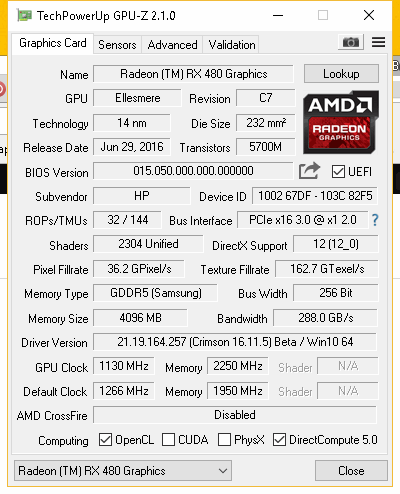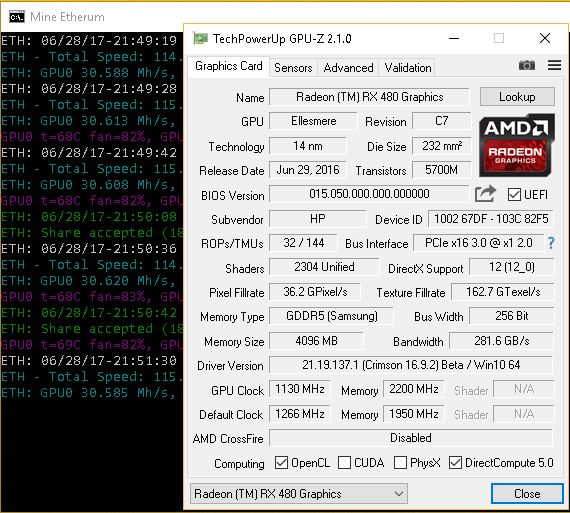Note: These directions worked for me when using the card on a Z97-based motherboard with AMD Radeon Driver version 16.9.2. As always, be wary of flashing any custom BIOS as there is always a risk of bricking your card.
On 6/19 Frys had a great sale for the HP Pavilion 560-p015hvr desktop PC. So there are now HP OEM RX 480 cards pulled from these systems on the market that are being snapped up by miners, though a quick Google yields no custom BIOS mods for mining. So I made my own that can get 31MH/s on Samsung chipped HP OEM RX 480 cards. Anyway, you probably got here by Googling “HP OEM RX 480 BIOS Mod” so I’ll cut to the chase.
Here are the specs of the single-fan HP cards I have (Again, this post is specific to Samsung memory variants; the visible overclocks got me 28MH/s on Claymore with the stock BIOS)

Using Polaris BIOS Editor, I first tried to mod the BIOS by copying the memory straps upward from 1500, but no success. Copied the memory straps upward from 1625 and it was still not quite stable. Tried the 1750 memory straps, and bingo! Make sure you are are using a driver version like 16.9.2 that plays nicely with cards that have a modded BIOS.
I am currently using this BIOS mod (stock BIOS with 1750 memory timings copied upwards) to mine Ethereum at 30.6MH/s in Claymore with an overclock to 2200 on the memory clock. A quick test of 2250 on the memory clock made it hit 31MH/s (!!!) in Claymore, but the single fan cooling and my terrible ambient temperatures (no AC, womp womp) made me settle for 30.6MH/s. Not bad for an OEM card!

(Disclaimer: I am not responsible for any bricked or otherwise damaged cards that result from people trying to replicate the above BIOS rom mods on their cards.)
TL;DR: Some HP OEM cards have Samsung memory. The cooling is a single fan, but it can handle Etherum mining fine. You can hit 28Mh/s with the stock BIOS with a simple overclock of memory to 2250mhz. Flashing a custom BIOS that moves the 1750 straps upward makes the card capable of hitting 31MH/s
P.S. If you are reading this and find a way to up the hashrate, please, please leave a comment and let me know. If you found this helpful, feel free to tip 0x44d601B0bE9E5C7B2256a149B8dCCd5B179657Ee (ETH)

I picked up an HP with this GPU that will be delivered tomorrow. I’d love to read more about your findings with your BIOS tweaks!
Do you have a Samsung variant? I got 31MH/s on mine!
Hi Brendan,
Please share your bios file,
Also can you explain how you made it?
Regards
I have the exact same card with Samsung ram. I just flashed your bios successfully but after reboot the PC cannot boot, with 6 long beeps. How do I flash it back to stock?
A computer not booting and beeping can indicate the system doesn’t detect a graphics card which in this case would likely mean the flash didn’t work properly.
A bad flash can happen for a number of reasons. Flashing cards in risers, having multiple cards in when flashing, flashing the card while it’s mining, or just bad luck can cause a bad flash. You may also not have the exact same card, as there could be multiple variants of HP RX 480s with Samsung RAM.
These cards do not have dual BIOS so your best bet is to put it in a computer with another card and see if you can get ATIFlash to recognize it, and flash the (backup) stock BIOS you pulled from your own card before flashing. If that doesn’t work, one other way to try to unbrick a card is to try this approach: https://forum.ethereum.org/discussion/9443/bricked-your-rx-480-due-to-bad-flash
Yah, I also used your BIOS on my Samsung card and it caused the same beeping situation. I put it in a riser as a second GPU and it booted and mined for me. But it actually got less mh/s. I need to edit the original bios I pulled off of it and flash that to the card again with my own modded original bios.
I’m busy as of late, but I’ll report back with my findings as well.
Also: it booted when I put the crippled card into my old core 2 duo PC as the only GPU. But I could not read any stats off of it. It was just a generic GPU.
I never used my card as a primary card/never actually plugged into it, and used it just for mining so maybe the mod doesn’t allow it to be used as a primary card. I took down the link to my BIOS in case others run into trouble, as clearly my success isn’t guaranteed to be replicated. Thanks for the comments though.
I’m interested if replicating my steps (flashing 1750 timings upwards) works for you too and if so, if our cards are actually different on a hardware level.
I was able to flash the card back to the original bios (ALWAYS BACK UP YOUR BIOS FIRST!) and it boots fine now. I decided not to change the straps with PBE, as I will game with mine occasionally as well.
If you have any interest, I could send you my original bios from my house 480. You could check out any differences.
That’d be great! If you could leave a link to your stock BIOS file or send it to my email (brendan.greenley@gmail.com) I’d be super interested to see if/how the BIOS differ!
Im interested in trying your BIOS, I just purchased 6 of these HP 480 cards. I will check to see if they are samsung memory and then try one, with your directions of course. Id love to give it a shot, even at the risk of one card dying.
If you grab PolarisBios Editor (https://github.com/caa82437/PolarisBiosEditor) I can walk you through what I did, then you’re much less likely to accidentally flash a different variant BIOS and brick it or otherwise run into trouble (though it is always a risk!)
What I did was exactly as described with my HP Pavilion and RX 480. Everything went ok, I did a backup of BIOS, flash it with replacing values from 1750 to up… I did that using atiWinflash and everything was ok.
When I restarted the machine, SURPRISE !!! Three long followed by three short beeps and black screen. 🙁
I tried everything that I can, and this HP Pavilion is not allowing to use onboard graphic when another gpu is anyhow connected (direct or with riser). So any of the possible recovering methods are useless, because as soon as I start the machine with card connected, I have 3+3 beeps and then nothing.
Any help, ideas what can I do ? (I don’t have another machine so I can try to recover old bios there)
Btw, specs are the same, Samsung memory, 4GB RAM, Release day…
I never tried using my card in the HP desktop it came with, and am wondering if the HP desktop is finicky about the cards, as Donnie also mentioned the card was boot-able in his older system, just not the HP.
Can you send me your BIOS files so I can see the changes/compare them to my own? I actually threw together an old Socket 775 system with eBay’d parts as a test bench that works for situations like this where you need to recover. I’d definitely try to borrow a friend’s PC if you can.
I have tried flashing 3 different cards I own following a few guides, (They all say take from 1750 and copy paste up) so I tried that and even beyond, however the problem is no matter what I flash becomes unusable! (Device manager reads it but shows the card with a warning “!” sign) I have tried to uninstall the drivers and hardware before and after the flash but I have been getting no luck whatsoever, any clue to what this is? Thanks for the wonderful guide and your time.
Copying straps from 1750 and upwards tends to be the go-to mod for RX 480 cards with Samsung memory. But the issue might be you have drivers that don’t like your modded BIOS, as I got a similar issue with “Code 43” errors in my Windows device manager that took me a lot of different potential fixes before they went away. Are you using driver version 16.9.2? (that version worked for me.) How many cards do you have in the system? (Windows can be fussy if you have lots of cards in one system.)
Even after I installed 16.9.2 drivers, I had Code 43 errors reappear after reboot which really confused me. Turns out Windows 10 kept “updating” my drivers in a way that broke them, as Windows treated newer AMD drivers as a “required” update. Disabling Windows Update’s downloaded AMD driver with this tool: https://support.microsoft.com/en-us/help/3073930/how-to-temporarily-prevent-a-driver-update-from-reinstalling-in-windows-10, turning off automatic updates/making it so Windows did NOT automatically search for drivers for new hardware, uninstalling all the cards in device manager in Safe Mode, and then doing a clean install of AMD Radeon 16.9.2 drivers finally got my cards recognized in Windows.
Hi Konemokai,
If you’re getting device manager problems, be sure and patch your drivers:
https://www.monitortests.com/forum/Thread-AMD-ATI-Pixel-Clock-Patcher
This fixed the issue for me. I’m running 4 cards and intend on adding two more.
You said that copying string 1500 to all above gave no succes. What does it mean? You had code 43 in device manager? Or your card didn’t start at all?
If you want to use new drivers with bios mod and do not have code 43 you have to download atikmdag-patcher and patch driver. It will turn off bios check by driver.
It booted fine since it wasn’t my primary card, it was just unstable at mining even at stock speeds.
I’m trying to follow these steps to up my hashrate as well. I’d like to see the 28Mh/s stock with overclocked mem before I flash the bios, but my hashrate when from 22 to 19 when I rolled back from latest AMD drivers to 16.9.2. Should I use latest drivers? Should I be configuring the cards with something other than WattMan? My cards have samsung ddr 5 ram.
For reference, here’s what I’m testing my hashrate with ethminer:
setx GPU_FORCE_64BIT_PTR 0
setx GPU_MAX_HEAP_SIZE 100
setx GPU_USE_SYNC_OBJECTS 1
setx GPU_MAX_ALLOC_PERCENT 100
setx GPU_SINGLE_ALLOC_PERCENT 100
ethminer.exe -G -M –opencl-platform 1 –opencl-device 1 –cl-extragpu-mem 0
I used Claymore Dual Miner in Ethereum only mode with these bat file settings:
setx GPU_FORCE_64BIT_PTR 0
setx GPU_MAX_HEAP_SIZE 100
setx GPU_USE_SYNC_OBJECTS 1
setx GPU_MAX_ALLOC_PERCENT 100
setx GPU_SINGLE_ALLOC_PERCENT 100
EthDcrMiner64.exe -epool eth-us-west1.nanopool.org:9999 -ewal wallet/worker/email -epsw x -tt 70,70,70 -tstop 89,89,89 -mode 1
Thanks for the response!
I had actually moved over to claymore as well and am getting better speeds, but not quite what you’re up to:
ETH – Total Speed: 101.139 Mh/s, Total Shares: 2, Rejected: 0, Time: 00:01
ETH: GPU0 26.531 Mh/s, GPU1 26.761 Mh/s, GPU2 23.917 Mh/s, GPU3 23.930 Mh/s
GPU2 and GPU3 weren’t stable with straps 1750 and up, so I could only copy up the final strap on those. GPU3 was running at 41Mh/s lol. But, perhaps if I redo and limit temps, it will run it slower?
I also attempted to run the memory clock speeds lower, but it caused the cards to crap out.
Any tips?
I’d expect it to be a little lower than my results since it’s been about a month. As time goes on, the DAG gets bigger, and Ethereum hashrate is slowing down on Polaris cards like the RX 470/480/570/580. The good news is a fix for the continual hashrate slowdown on these cards may be coming soon: http://1stminingrig.com/amd-working-on-ethereum-mining-hashrate-drop-fix-for-polaris-gpus/
Also, I was using the Windows 10 Anniversary update (which some see performance gains in) and was not using the card to drive a display/any other programs which also could help my hashrates. Hope this helps!
Can you email me this bios please coin0325@gmail.com
Hi,Brendan
I have a hp rx 480 video card,and according your method mod the core 1150,mem 2080,1625 timing.
But at last, when it mining eth ,only 19MH/S .Then I found its core works between 600 and 900!
How was that happen and what can I do for 30MH/S for this HP RX 480 CARD?
Thanks.
thank you im gonna try it